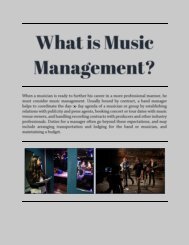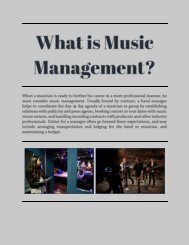What is Guerilla Filmmaking
Guerilla filmmaking is a term used to describe low-budget films that do not meet the typical production values of a studio film.
Guerilla filmmaking is a term used to describe low-budget films that do not meet the typical production values of a studio film.
- TAGS
- film
- filmmaking
- films
- guerilla
You also want an ePaper? Increase the reach of your titles
YUMPU automatically turns print PDFs into web optimized ePapers that Google loves.
WHAT IS
GUERILLA
FILMMAKING?
Image Source:
https://www.jmcacademy.edu.au/
Article Source:
https://www.wisegeek.com/what-isguerilla-filmmaking.htm
Guerilla filmmaking is a term used to
describe low-budget films that do not meet
the typical production values of a studio film.
Films made in this process are usually made
for less money, with a smaller crew and less
equipment. Although many see the lack of
resources as a detriment, supporters believe
that freedom from oversight common to
guerilla films is worth the hardships, at least
on an artistic level.
A film is typically considered "guerilla" if it
does not subscribe to the rules and
regulations of the Hollywood film industry. In
a studio picture, cast and crew typically
belong to unions that enforce specific rules
regarding the treatment of their members.
Moreover, the producing studio and any
invested affiliates maintain a degree of
control over the finished product.
Guerilla filmmaking creates a different
animal altogether. Films are typically funded
by members of the creative team or private
investors. This gives the team considerably
more control over the finished product, as
they now must only attract a distributing
company to have their film released in
theaters. With the advent of the Internet,
guerilla filmmakers gained even more
control over their product, as they can
release and distribute online fairly
inexpensively and without a distribution
company.
Job descriptions for crew members may also become a little
murky in the guerilla process. With less money or status at
stake, cast and crew sign on primarily to enjoy the project or
help out friends. Without the strict regulations of the unions,
members of the crew may find themselves filling whatever
positions are necessary for any given scene or day.
An additional, though less publicized, part of guerilla
filmmaking can include some illegal activity. In most places,
permits are required by government officials before
allowing film crews to shoot in public. Some guerilla
and independent films will simply ignore these requirements;
able to sneak shots in by using only a single small camera so
as not to attract attention. In Sofia Coppola's Lost In
Translation, the crew used guerilla tactics to shoot a wide shot
of Shibuya Crossing in Tokyo by sneaking a cameraman into a
nearby coffee shop that featured a view of the street. These
tactics may save a production much-needed money, but can
be dangerous or costly if a problem should occur or if officials
take notice.
Although guerilla filmmaking avoids the
trappings of the Hollywood machine, wellmade
films can still be created. Many famous
directors have gained major media attention
through self-made films shot in the guerilla
style, including Darren Aronofsky and Spike
Lee. Many proponents of this filmmaking
style insist that the lack of
micromanagement from studios allows the
creative freedom to explore ideas that many
studios reject. An "art of the people" in some
respects, guerilla filmmaking can allow the
production of controversial, thoughtprovoking
films that might not otherwise be
made.








